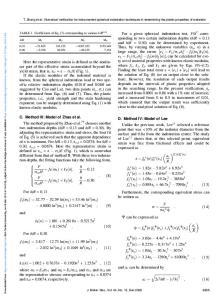Spherical indentation for determining the phase transition properties of shape memory alloys
- PDF / 608,998 Bytes
- 5 Pages / 584.957 x 782.986 pts Page_size
- 70 Downloads / 329 Views
Dongyang Li Department of Chemical and Materials Engineering, University of Alberta, Edmonton, Alberta, Canada T6G 2G6
Zhongrong Zhou Tribology Research Institute, National Traction Power Laboratory, Southwest Jiaotong University, Chengdu 610031, Sichuan Province, People’s Republic of China (Received 13 July 2008; accepted 17 November 2008)
A spherical indentation method was developed to characterize the phase transition behaviors of shape memory alloys (SMAs). Based on deformation analysis, the measured indentation force-depth curves of SMAs can be converted to their nominal stress-strain curves. The predicted elastic modulus and phase transition stress of SMAs from spherical indentation agree well with those directly measured from tensile tests. This approach should be especially useful for characterizing the phase transition properties of SMA materials of small size or thin films. I. INTRODUCTION
Due to the reversible phase transition between the low-temperature martensite phase and high-temperature austenite phase, NiTi shape memory alloys (SMAs) may exhibit the shape memory effect or superelastic behavior.1,2 Because of their unique phase transition properties, good microwear resistance and high work output per unit volume, NiTi SMAs have become the promising materials to make sensors or actuators in MEMS.3,4 In these applications, the characterization of the phase transition properties of NiTi is an important issue of extensive interest, especially for NiTi films and components of small size.5,6 With considerable contributions from Oliver and Pharr and many others,7,8 the indentation technique has become an effective approach to test mechanical properties, such as Young’s modulus and yield stress of elastic or elastoplastic materials. However, the deformation behavior of SMAs is complicated due to the coexistence of phase transition and plasticity. So far, no effective method is available to quantify the phase transition properties of SMAs by indentation, although several attempts were made previously to achieve the goal.9–14 Different from the indentation with Berkovich tip, spherical indentation has been proved as an adequate technique to determine the deformation behavior of materials including purely elastic deformation, a)
Address all correspondence to this author. e-mail: [email protected] DOI: 10.1557/JMR.2009.0082
1082
http://journals.cambridge.org
J. Mater. Res., Vol. 24, No. 3, Mar 2009 Downloaded: 01 Apr 2015
full plastic flow, or both.15–17 Because the spherical indentation may induce full phase transition flow in NiTi SMAs at a relatively smaller load and plastic flow at a higher load, it is possible to develop a spherical indentation method to characterize the phase transition behavior of NiTi SMAs. It is well known that for very small samples or thin films, it is extremely difficult or impossible to perform direct tensile tests. The purpose of this research is to show that the spherical indentation technique can be used to obtain the indentation force-depth (F-h) curve of SMAs under ful
Data Loading...











